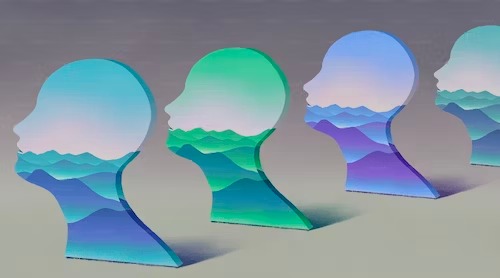Mindmaps are great for brainstorming – things that we need to rearrange from time to time. Mental palaces are great for atomic pieces of knowledge, as even a small unit can encode a lot of information. Placing mental palaces within mental maps and mental maps on the walls of mental palaces we enjoy both options. Creative associative connections within these object is a very different and harder challenge.
What are mental landscapes?
Maps are built for navigating landscapes. We can use mental maps to navigate mental landscapes. And I mean actual visualization of terrain with houses, trees, and sculptures.
A mental landscape can also be a mental palace, only an outdoor variety. We can embed physical objects into a very familiar landscape we remember only too well.
We can also use a totally virtual landscape from science fiction or a video game, maybe even from religious texts. This should be a place we would find very familiar, very easy to navigate, and emotionally safe.
What we put within is another matter.
3D mental objects
Since landscapes are usually 3-dimensional, so we can put within them 3-dimensional objects. Sculptures usually anchor our attention and provide context. For immutable resources, we can place houses or palaces. Regular mindmaps can be easily transformed into mental trees: 3-dimensional or cut out of tin foil.
The mindmaps can be easily manipulated for changing information. Mental palaces can be moved around the mental landscape. Modifying the landscape itself is much harder. So once we plan hills and valleys, rivers and streets, the landscape should not change.
3D clustering objects
Hills serve as large clusters of knowledge. Rivers separate poorly connected clusters. Valleys are great for interdisciplinary activity and are often the most fertile part of the landscape.
Major streets can be used for the most important paradigms, with squares for the places where multiple paradigms meet. Within larger paradigms, there are smaller schools and positions, so there are always more streets to make. The major streets do not change, as major paradigms do not appear very often.
Scaling
In theory, one can make huge maps with interconnected landscapes. Also in theory, one can place a model landscape on a table in a hall of a mental palace. This allows for at least three levels of scaling. I do not actively use this approach, and I do not know anyone who uses it. While potentially very effective, there was simply no need to apply it.
The view from the window
One of the best things in mental landscapes is context. If you put a statue or a special palace on the top of a hill, it will be potentially visible from some of the windows of every mental palace on the hill. You may also get glimpses of squares and statues in them. Notice that your mental landscape does not have to be physically correct and account for all raytracing details. It simply needs to be easy to memorize, navigate and modify. So all mental palaces we want to be translucent might as well be translucent.
Other windows may look at the backyard with context common to very few buildings. We can control the scope.
Navigating mental landscape
Going from place to place like a regular human is too slow. Teleporting in god mode can be contextually disorienting. We can choose to move like a superhero, for example, iron man and his flying suit. Alternatively, we may use some visualized mass transit. Or combine both, the way superman does in a phone booth.
The advantage of mass transit is the availability of fixed locations to visit and some contextual shortcodes. The main role of the mental landscape is to provide context: all the important information is encoded within specific palaces. So the more context we can encode, the better.
Associative connections
There are many ways to build associative connections. Close palaces share a view from the relevant window. We can also make underground passages between them. It is a bit of cheating but in a nice way.
It is possible to place photos of other parts and time snapshot of the mental palace. These sorts of pictures can be placed very conveniently on walls of mental palaces.
In theory, one can place colored telegraphs and telephones in key locations. There can be only very few such connections, so use them sparingly.
For me, the most effective way to generate such connections is to place a TV set with some local news. The journalists can be traveling all around, so each time the association might be different.
Graphs and diagrams
Graphs and diagrams can be presented as abstract sculptures within the landscape. For example, you can place a Japanese stone garden anywhere you want. There are many novelty games with balls and strings. You can visualize pretty much everything you want, including train stations with trains visiting specific locations with very specific synchronization. Small gardens with complex landscapes take a place of a couple of mental palaces.
Negative space
It is best if your mental palaces benefit from the local features of your mental landscapes. Crowded spaces are stressful. You do not have to pay for real estate, and you can bend the laws of physics a bit. So add many empty spaces with greenery. Maybe even a lake or mountains in a distance. The reason is recreational more than practical. You need to spend a lot of time in your mental palace, and well-being there costs nothing. So you can easily create a paradise.
Capacity
I once calculated that a small mental city or mental forest without trying too much can easily hold a million keywords. That is more than enough for a reasonable subject.
Limitations
So why we do not hear everybody talking about mental landscapes? They are damn hard to manage. Start with the need to allocate spaces for specific areas of knowledge. This requires some sort of planning. Memory masters learning foreign languages may place some sorts of typical contextual locations within their mental cities, but hardly the rest of us.
Unless we are doing something monumental, we do not need access to so much organized information at any given time. A single mental palace can be tweaked to encode from several dozens to many thousands of pieces of knowledge. There is more than most people operate, especially operate with a good plan.
So mental landscapes are good when working on a PhD, a massive project for a corporate or government body, a serious blog, or a book. Maybe they are useful for medical and legal information, such as taxation laws.
Do not expect to hear memory masters winning competitions via complex landscapes. All the memorization tasks of a competition fit within a city street. Life is more complex than memory competitions.

Get 4 Free Sample Chapters of the Key To Study Book
Get access to advanced training, and a selection of free apps to train your reading speed and visual memory

